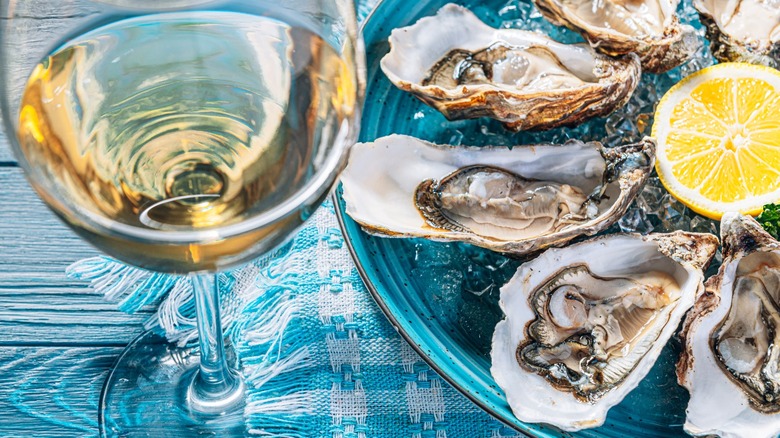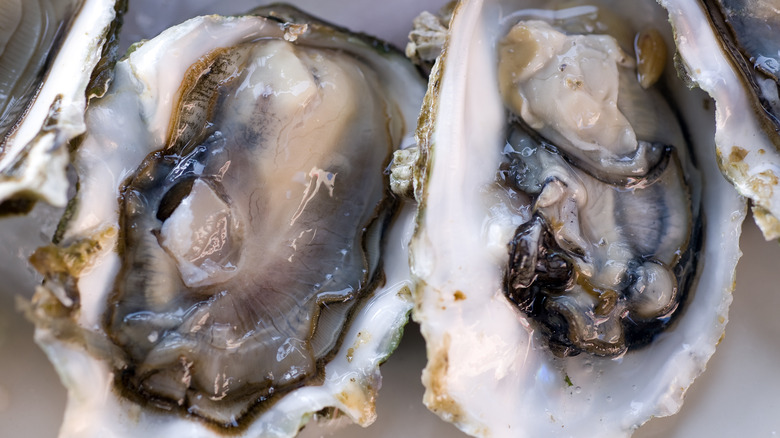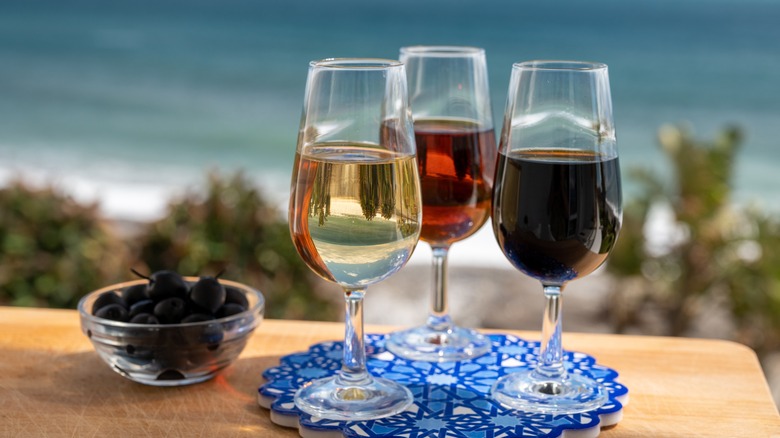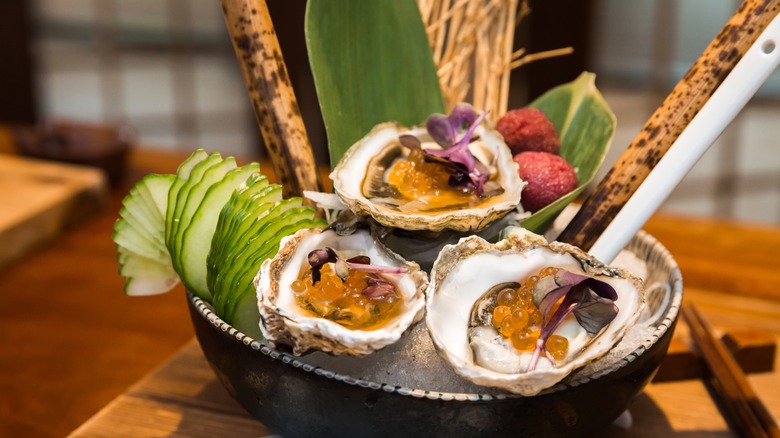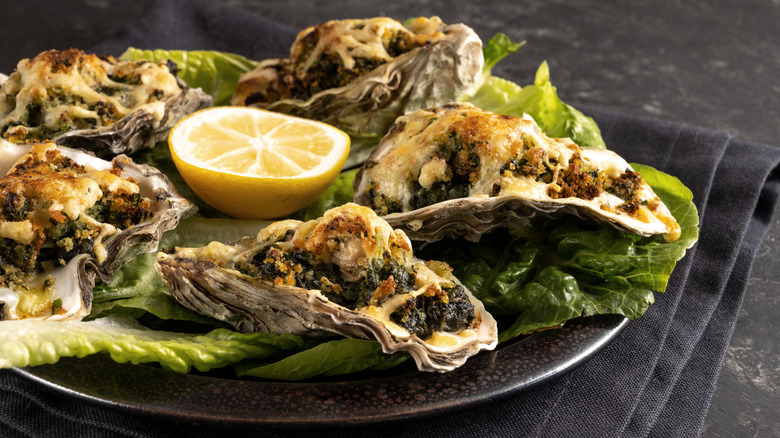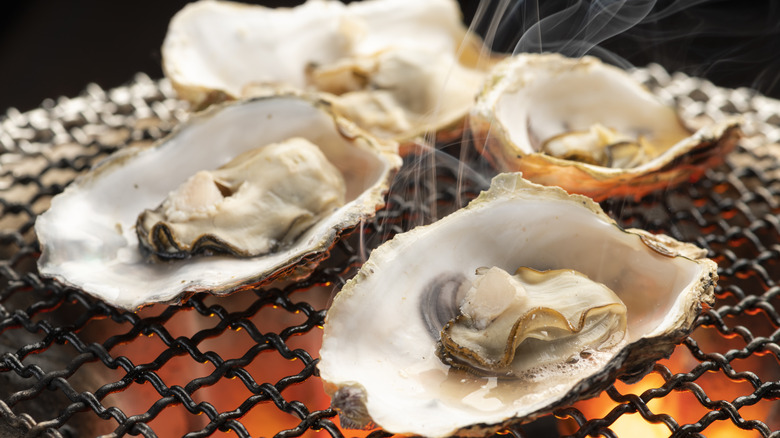The Best Wines To Pair With Oysters, According To A Sommelier
Slurping back a half-dozen oysters and sharing a bottle of wine with friends is one of life's simplest pleasures. Salty oysters and sweet wine feel like a combination made in culinary heaven, but not all combos are created equal. Oysters and wine have at least one thing in common: Each variety has a specific name that gives little information to the untrained eye about their distinct tastes.
Most people don't know the difference between a chenin blanc, a riesling, or an Olympia oyster from a beach plum oyster, so we created this combination list. Doreen Winkler, who has worked as a sommelier and wine consultant for over a decade, owns a wine shop in New York City called Orange Glou and spoke with Foodie to advise which wines work the best with seven different types of oysters. So, before you get shucking your oysters, discover which bottle you should be uncorking to pair.
Casa Belfi anfora frizzante with Chelsea Farms gem oysters
Orange and skin-contact wines have become increasingly popular at restaurants and wine bars nationwide over the past year. Orange wines are made from grapes traditionally used for white wine but fermented in the same way as red wine. Casa Belfi Anfora Frizzante comes off more as vibrant yellow than orange, but still pairs perfectly with fried fish, shellfish, or oysters.
According to Dorreen Winkler, Casa Belfi Anfora is made from glera grapes, which are the same as those used to create prosecco. These grapes make a naturally sparkling, almost Champagne-like wine with notes of citrus and smoke.
Chelsea Farms gem oysters are "clean, sweet, buttery" oysters from the coast of Washington state that, according to Winkler, "go amazingly with Casa Belfi Anfora Frizzante, NV, a sparkling orange wine from Veneto, Italy, which offers depth and acidity to complement the buttery plump texture of the oyster." These oysters are just slightly briny, bringing out the citrusy sweetness of Casa Belfi Anfora Frizzante.
Domaine Lebled sauvignon blanc with Olympia oysters
Though "tiny in size," Olympia oysters carry a big flavor with "rich coppery and mushroom notes," according to Doreen Winkler. The brine, by comparison, is subtle with "a hint of celery salt." West coasters are probably familiar with this type of oyster, as they're the only species native to this side of North America. Named after Olympia, Washington, where they were first discovered in abundance around 1850, Olympia oysters are commonly eaten year-round throughout the West Coast and paired with various wines.
According to our expert, one wine that stands out is the Domaine Lebled sauvignon blanc, hailing from the Loire Valley region in France. This white wine "is light enough to not overpower the oyster, yet its dry and minerally profile balances out the natural saltiness of the oyster." Domaine Lebled is made sulfur-free and is best served chilled next to a dozen oysters on ice.
Riesling with beach plum oysters
Beach plum oysters are farmed in Buzzards Bay, part of the Atlantic Ocean off the southeastern coast of Massachusetts. This oyster species is particularly large compared to the West Coast's Olympia oysters. Doreen Winkler describes beach plum oysters as having "a light brininess with a creamy taste and sweet, earthy finish that lingers." One of the more hearty varieties of oysters, Winkler says the salty and earthy taste of beach plums even reminds some people of eating chicken thighs.
What goes better with a salty, savory oyster than a dry wine? Our expert recommends pairing a German riesling, particularly a spätlese trocken ("dry" in German). "It's rich and dense with notes of red apple, apricot, and honeysuckle, perfect with those plump and briny oysters." The grapes used to make this riesling are harvested later than usual in the season, allowing them to ripen longer and develop a stronger flavor concentration.
La Guita manzanilla sherry with Standish Shore oysters
Standish Shore oysters are found in Duxbury Bay, about 40 miles north of Buzzards Bay and their beach plum oyster cousins. Part of Cape Cod Bay, these oysters thrive in volatile tides that provide plenty of nutrient-rich water. Some of the oysters are on the smaller side, particularly the petites, making these great oysters for beginners struggling with a heartier mouthfeel. Doreen Winkler explains that Standish Shore oysters are "buttery-sweet" but heavy on the brine, a flavor contrast that helps them stand out.
Standish Shore oysters are a great pairing for a sherry, "a fortified wine made from Palomino grapes in southern Spain." The La Guita manzanilla sherry is "light, delicate, minerally and dry" with a saline aftertaste that pairs well with the brininess of a Standish Shore oyster. This "zesty" wine is bottled more frequently than other wines to maintain a standard of excellence in freshness.
Chenin blanc with Kumamoto oysters and kiwi mignonette
Kumamoto oysters are native to Japan, but due to their increased popularity worldwide, are now also grown in oyster farms on the West Coast of the United States. These oysters are best known for their sweet, almost fruity, and melon-like taste that pairs well with sweet wine and a sweet sauce. "Mignonette made with red wine vinegar, shallots, and black pepper is a classic accompaniment for oysters," says Doreen Winkler, "but when it's punched up with green kiwi for a bit of tropical freshness, it really complements the natural sweetness of Kumamotos."
Chenin blanc is a white wine from France that has a wide range of expression from sparkling to very dry. Pair your plump oysters with the Domaine de Belliviere Premices Jasnieres 2019 from the Loire Valley. Winkler advises that the "floral notes of honeysuckle and ripe pear complement the oyster and tropical freshness of the mignonette."
Chardonnay with Chesapeake Bay oyster Rockefeller
Feel a little fancy with this combo of classic chardonnay and warm oyster Rockefeller, "a rich, old-school dish where an oyster on the half-shell is topped with a butter or cream sauce, herbs, spinach, cheese, some breadcrumbs and then broiled," as our expert Doreen Winkler puts it. Unlike plain oysters served as cold as possible, oyster Rockefeller is naturally a bit heartier.
Chesapeake Bay oysters make the best candidate for oyster Rockefeller because they're large enough to support all the extra goodness that comes on top. These Virginian oysters are plump and meaty but don't pack much flavor or saltiness.
A simple buttery chardonnay works well with this dish. Consider a new-world chardonnay from the Arnot-Roberts Watson ranch in California, as it "offers a nice level of acidity with notes of apple, citrus, and buttery oak, cutting through the richness of the [oyster Rockefeller]."
Mtsvane with grilled kusshi oysters
If you want to get creative with another way to heat your oysters this summer, try grilling some British Columbian kusshi oysters. These "often-large oysters used for grilling have a meaty chew and a nice briny flavor." They're one of the best varieties to grill because of their meatiness and the shell's deepness, allowing them to "stay on the grill easier." Cook for a few minutes with butter, parmesan cheese, citrus, garlic, and fresh herbs like thyme or parsley.
A perfectly grilled oyster pairs well with the zest and inventiveness of an "orange (aka skin contact) wine like a mtsvane from the Republic of Georgia, which is fresh and layered with notes of tropical citrus fruit." Mtsvane may be an unfamiliar wine name state-side, but winemaking in Georgia dates back around 8,000 years ago, making it one of the first countries in the world to make wine.
- If you're interested in other wine and food combinations, check out how we paired pizza and wine like an expert.
